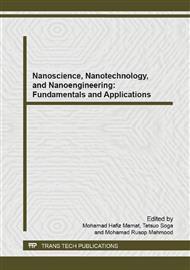p.45
p.50
p.55
p.60
p.64
p.69
p.73
p.78
p.83
Fabrication of Micro-Gap Structure by Reactive Ion Etching Technique (RIE) for Future Reproductivity of Nanogap Biosensor
Abstract:
The important role of reactive ion etching (RIE) technique is to etch the semiconductor surface directionally. The purpose of the current research is to fabricate polysilicon micro-gap structures by RIE technique for future biosensing application. Therefore zero-gap microstructure of butterfly topology was designed by using AutoCAD software and finally the designed was transferred to commercial chrome glass photomask. Ploysilicon wafer samples were selected to achieve high conductivity during electrical characterization measurement. The fabrication process starts from samples resist coating and then by employing photolithography through chrome glass photomask the zero-gap pattern of butterfly topology was transferred to resist coated sample wafer followed by resist stripping from exposed area and finally by reactive ion etching (RIE) technique the open area of polysilicon was etched directionally at different etching time to fabricate micro-gap structure on wafer samples. The spacing of fabricated micro-gap structures will be further shrink by thermal oxidation (size reduction technique) until to nanosize gap spacing. The proposed nanospacing gap will definitely show the capability to detect the bio molecule when inserted into the gap spacing.
Info:
Periodical:
Pages:
64-68
Citation:
Online since:
June 2015
Authors:
Keywords:
Price:
Сopyright:
© 2015 Trans Tech Publications Ltd. All Rights Reserved
Share:
Citation:


